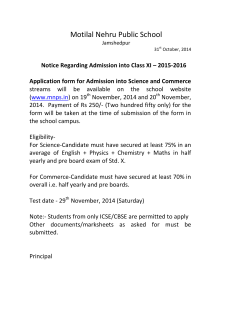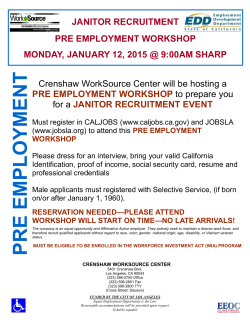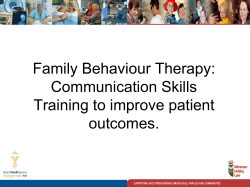
PrePostTests Webinar-FINAL.
This webinar is hosted by: Capacity for Health at APIAHF, a Capacity Building Assistance Program, with offices in San Francisco and Washington D.C. Who we are: Our program is funded by the Centers for Disease Control and Prevention (CDC) to provide free trainings and one‐on‐one technical assistance for community‐based organizations: • Organizational Infrastructure and Program Sustainability • Evidence‐Based Interventions (EBIs) and Public Health Strategies • Monitoring and Evaluation Webinar: Pre/Post Tests Housekeeping All participants are automatically muted by webinar administrators. For discussion, please “raise” your hand. You will be called on and un‐muted so that you can ask your question live. If your audio is through a telephone, please make sure to enter your audio PIN, otherwise we are unable to unmute you. You may ask questions by typing them in using the questions feature. If anyone is watching the webinar with multiple people around one computer, please type in your contact information in the questions box so that we can include you on any follow up. Today’s webinar will be recorded. The recording will be available on our website. Webinar: Pre/Post Tests Presenter‐Kristin Fernandez, MPH Kristin has spent the majority of her career working with HIV and other health programs as a health educator, research associate and program manager. Currently, she consults with various health agencies as a grant writer and program planning and evaluation specialist. When not working, she is chasing around her 2 year old daughter. Webinar: Pre/Post Tests Today’s Agenda • Presentation (50 minutes): 1. What are pre/post tests? 2. How to design pre/post tests 3. Beyond the questionnaire: alternative styles of pre/post tests • Question and Answer (10 minutes) Webinar: Pre/Post Tests Quick Poll • Have you ever used a pre/post test as part of a program evaluation? Webinar: Pre/Post Tests Learning Objectives By the end of this presentation, participants will… Understand what pre/post tests are, and how they are useful Understand the limitations of pre/post tests Be able to form questions for pre/post tests based on program‐specific objectives Be able to identify several alternatives to questionnaires Feel confident designing a pre/post test Be able to define next steps for their agency Webinar: Pre/Post Tests Today’s Agenda • Presentation (50 minutes): 1. What are pre/post tests? 2. How to design pre/post tests 3. Beyond the questionnaire: alternative styles of pre/post tests • Question and Answer (10 minutes) Webinar: Pre/Post Tests What are Pre‐ and Post‐ Tests? Instruments that measure behavioral determinants about a subject the program targets to change Webinar: Pre/Post Tests What are Pre‐ and Post‐ Tests? These measures are captured at 2 points in time Pre‐test of participant group Post‐test of participant group Program Activities Baseline measures End‐line measures Adapted from http://designmonitoringevaluation.blogspot.com/2010/03/pre‐and‐post‐test‐project‐group‐no.html Webinar: Pre/Post Tests What are Pre‐ and Post‐ Tests? Comparing participants’ results produces an estimation of the program’s effect Pre Webinar: Pre/Post Tests + Post = difference? Pre/Post Tests… • Are used to evaluate program outcomes • Are best for measuring short‐term impact • Can be used for routine monitoring • Are often in short questionnaire format • Alternatives will be discussed at the end of this presentation Webinar: Pre/Post Tests Evaluation Framework Step 1 Determine Purpose and Uses Step 2 Develop Measurable Objectives Step 3 Develop Evaluation Questions Step 4 Collect/Gather Credible Evidence* Step 5 Analyze Info/Develop Conclusion Step 6 Report Findings *Pre/Post Tests used here Source: APLA Shared Action Webinar: Pre/Post Tests Step 4: Collect/Gather Credible Evidence 1) Identify types of information needed 2) Determine sources for information 3) Select methods to collect information 4) Define procedures to collect information Webinar: Pre/Post Tests What questions do we want answered? Who will give us this these answers? How will we gather this information? When and where will we collect this information? Step 4: Collect/Gather Credible Evidence What questions do we want answered? Is the program WORKING? How? Who will give us this these answers? PARTICIPANTS How will we gather this PRE and POST tests information? When and where will we collect this information? Webinar: Pre/Post Tests BEFORE the program begins and AFTER it ends Benefits of Pre/Post Tests They’re Cheap They’re Easy They’re Useful Webinar: Pre/Post Tests Drawbacks of Pre/Post Tests • Other factors in participants lives could also be influencing the changes seen • Rely on self‐reported information Webinar: Pre/Post Tests Pre/Post tests CAN help us say: “Based on pre‐ and post‐test results, change happened, and we think the program may have influenced this.” Webinar: Pre/Post Tests They CAN’T help us say: “Based on pre‐ and post‐test results, the program alone caused the change.” Webinar: Pre/Post Tests Questions? • Please “raise” your hand to be un‐muted or type into the Questions feature Webinar: Pre/Post Tests Today’s Agenda • Presentation (50 minutes): 1. What are pre/post tests? 2. How to design pre/post tests 3. Beyond the questionnaire: alternative styles of pre/post tests • Question and Answer (10 minutes) Webinar: Pre/Post Tests Case Study Your agency provides weekly after‐school HIV risk‐reduction workshops to teens. These workshops take place over 10 weeks. During these workshops, teens learn how reduce their risk for HIV and other STDs through activities, skill‐building exercises and verbal and visual presentations. Webinar: Pre/Post Tests Case Study Cont’d You will use pre‐ and post‐tests in order to quickly and cheaply gather info and assess the program’s impact. The results will be used to refine the program and will be included in an upcoming grant application. Where do you begin? Webinar: Pre/Post Tests Designing Pre/Post Tests Step 1: Look at your program’s intended objectives Step 2: Design test questions based on objectives & indicators Step 3: Organize questions appropriately Step 4: Pilot & revise Webinar: Pre/Post Tests Designing Pre/Post Tests: Step 1 Step 1: Look at your program’s intended: goals objectives indicators Webinar: Pre/Post Tests Quick Poll • Do you know where your program’s goals and objectives are located? Webinar: Pre/Post Tests Evaluation Framework Step 1 Determine Purpose and Uses Step 2 Develop Measurable Objectives Step 3 Develop Evaluation Questions Step 4 Collect/Gather Credible Evidence* Step 5 Analyze Info/Develop Conclusion Step 6 Report Findings *Pre/Post Tests used here Go BACK and look at Step 2 and Step 3 Webinar: Pre/Post Tests Case Study: Step 1 Objective: “By end of program year, at least 80% of participating teens will demonstrate increased knowledge of HIV risk‐reduction strategies.” Indicators to this objective: 1. Can name the 5 body fluids that transmit HIV 2. Can list 2 strategies to increase condom use Webinar: Pre/Post Tests Caution! Objective: “By end of program year, at least 80% of participating teens will demonstrate increased knowledge of HIV risk‐reduction strategies.” This does NOT mean this objective will be met at the end of each session! Webinar: Pre/Post Tests Designing Pre/Post Tests: Step 2 Step 2: Design test questions based on objectives & indicators • Try to design at least one question around each program objective in your pre‐ and post‐test • Use indicators to guide wording, question type • Don’t ask questions that require participants to remember picky details • Be sure to ask questions for which a clear answer was given over the course of the program! Webinar: Pre/Post Tests Common Question Styles • Ones in which a participant marks an answer What day is it today? (CIRCLE ONE) Monday Tuesday Wednesday Thursday Friday • Ones in which a participant rates a certainty of knowledge, feeling, or opinion How well do you agree with the following statement? “Condoms should be available in schools” (CIRCLE ONE) Strongly Agree Agree Disagree Strongly Disagree Webinar: Pre/Post Tests Common Question Types • Open‐ended Describe your day:_____________________ (WRITE IN) • Closed‐ended Did you use a condom today? (CIRCLE ONE): Yes No • Partially open‐ended I usually forget to use a condom when (CHECK ALL THAT APPLY): I’m drunk or high I’m not at home Other:________ (write in) Webinar: Pre/Post Tests Common Answer Types • Ordinal • Interval Strongly Agree, Agree, Disagree, Strongly Disagree 0‐10, 11‐25, 25‐50, 50+ 1 to 5 with 1 = LOW and 5 = HIGH • Nominal • Numerical Yes/No Male/Female/Transgender 165 lbs 39 yrs old 11th grade Webinar: Pre/Post Tests Case Study: Step 2 Which of the following body fluids transmit HIV? (Check all that apply): Blood Saliva (spit) Breast milk Semen (cum) Vaginal fluids Vomit (puke, barf) Pre‐ejaculatory fluid Sweat Webinar: Pre/Post Tests This question addresses one of the program’s stated objectives: By end of program year, at least 80% of participating teens will demonstrate increased knowledge of HIV risk‐reduction strategies It uses the objective’s specific indicator as a guide for the question Can name the 5 body fluids that transmit HIV Case Study: Step 2 What 2 strategies will you try in order to help you use condoms every time you have sex? 1.____________________ ___________________ 2.____________________ ___________________ This question addresses one of the program’s stated objectives By end of program year, at least 80% of participating teens will demonstrate increased knowledge of HIV risk‐reduction strategies It uses the objective’s specific indicator as a guide for the question Can list 2 strategies to increase condom use (participants write in answers) Webinar: Pre/Post Tests Designing Pre/Post Tests: Step 3 Step 3: Organize questions appropriately Logical order of questions: 1. Sensory/physical: What do you see when you walk into a clinic…? Where do you go when you need STD testing…? 2. Knowledge/feeling: How do you feel when you have unprotected sex…? What is the ‘window period’ for HIV…? 3. Opinion/values: What is your opinion of sex education in schools…? 4. Analytic/action: How long does it take to put on a condom properly…? How would you prepare to have safe sex on a date…? Webinar: Pre/Post Tests Case Study: Step 3 Which of the following body fluids transmit HIV? Blood Saliva Breast milk Semen Vaginal fluids Vomit Pre‐ejaculatory fluid Sweat = Knowledge question Webinar: Pre/Post Tests What 2 strategies will you try in order to help you use condoms every time you have sex? 1._______________________________ _________________________________ 2._______________________________ _________________________________ = Analytic/Action question Designing Pre/Post Tests: Step 4 Step 4: Pilot & revise • Pilot the tests with staff and participants • Ensures the questions are well written and make sense • Ensures correct answers are due to actual knowledge, not flaw in test design • Eliminate or change any unclear questions Webinar: Pre/Post Tests Case Study: Step 4 1. Copies of the pre/post test piloted with staff 2. First revision 3. Pre/post test piloted with participants 4. Second revision 5. Process repeated Webinar: Pre/Post Tests Questions? • Please “raise” your hand to be un‐muted or type into the Questions feature Webinar: Pre/Post Tests Common Styles of Pre/Post Tests • Taken at 2 points in time • Taken at 1 point in time • “Post‐only” • “Retrospective pre‐test” Webinar: Pre/Post Tests Retrospective Pre‐Test Design 1) Participants rate their knowledge, skill, attitude or behavior AFTER completing the program, then 1) Reflect back to how they were BEFORE the program and report and rate the same knowledge, skill, attitude and behavior Webinar: Pre/Post Tests Case Study: Retrospective Pre‐Test Please check the box that describes how well you knew this information BEFORE participating in this program: “The 5 fluids that transmit HIV” I knew this very well I knew this pretty well I knew this a little I did not know this Webinar: Pre/Post Tests Case Study: Retrospective Pre‐Test Please check the box that describes how well you know this information NOW/AFTER participating in this program: “The 5 fluids that transmit HIV” I know this very well I know this pretty well I know this a little I do not know this Webinar: Pre/Post Tests Case Study: Retrospective Pre‐Test Please check the box that describes how well you could do the following task BEFORE participating in this program: “I can use strategies that will help me use a condom” I could do this very well I could do this pretty well I could do this a little I could not do this Webinar: Pre/Post Tests Case Study: Retrospective Pre‐Test Please check the box that describes how well you could do the following task NOW/AFTER participating in this program: “I can use strategies that will help me use a condom” I can do this very well I can do this pretty well I can do this a little I cannot do this Webinar: Pre/Post Tests Case Study: Retrospective Pre‐Test Please rate your level of knowledge, skill and confidence in the following areas BEFORE and AFTER this program A LITTLE SOME A LOT Confidence to say no to sex NONE Confidence in protecting myself A LOT Skill in negotiating condom use SOME Knowledge about condoms A LITTLE Knowledge about HIV AFTER NONE 1 is LOW and 4 is HIGH BEFORE 1 2 3 4 1 2 3 4 1 2 3 4 1 2 3 4 1 2 3 4 1 2 3 4 1 2 3 4 1 2 3 4 1 2 3 4 1 2 3 4 Benefits of Retrospective Pre‐Test • Program doesn’t start with a test • Same “frame of reference” • Convenient Webinar: Pre/Post Tests Limitations of Retrospective Pre‐Test • Doesn’t measure actual knowledge, skills, etc. (only perceptions!) • Recall may be difficult for some • Culture, language skills, literacy level, age Webinar: Pre/Post Tests Questions? • Please “raise” your hand to be un‐muted or type into the Questions feature Webinar: Pre/Post Tests Today’s Agenda • Presentation (50 minutes): 1. What are pre/post tests? 2. How to design pre/post tests 3. Beyond the questionnaire: alternative styles of pre/post tests • Question and Answer (10 minutes) Webinar: Pre/Post Tests Beyond the Questionnaire • Questionnaires are not the best format for all target populations • Some things are better SHOWN Webinar: Pre/Post Tests Alternatives to Questionnaires • Card‐sorting • Temperature gauge • Labels, stickers, dots • Observation …and more! Webinar: Pre/Post Tests Case Study: Card‐Sorting • Participants are given answer options on index cards • They choose the correct answers and group them together under categories Webinar: Pre/Post Tests “Transmits HIV” “Doesn’t transmit HIV” Case Study: Temperature Gauge “I feel confident that I can • Participants put a sticker on a picture of a increase my condom use.” thermometer or other AGREE image to represent how they feel about something DISAGREE After program Before program Webinar: Pre/Post Tests Case Study: Temperature Gauge • As a group, participants “I feel confident that I can put a dot next to the increase my condom use.” thermometer to AGREE represent how they feel • Dots can be color‐coded for variables like age, gender, zip code, etc. DISAGREE Webinar: Pre/Post Tests Case Study: Labeling Please label the following: • Participants label a diagram or picture 1. • Labels contain answer choices plus a few extra choices vagina ovary follicle endometrium uterus 2. 3. 4. cervix fallopian tube Webinar: Pre/Post Tests clitoris 5. 6. Case Study: Observation • Participants are observed by program staff and behaviors are noted • Great for skill demonstration! Webinar: Pre/Post Tests “Pair off with the person next to you. Show them how to put a condom on the condom demonstrator correctly from start to finish.” Further Resources Slides, a recorded version of this webinar, and links to further resources will be available on our website at: www.capacity4health.org Contact us for individualized capacity-building assistance: Sonya Dublin, Capacity for Health 415-568-3335, sdublin@apiahf.org Webinar: Pre/Post Tests This webinar is part of a 6 part series… Webinar: Pre/Post Tests
© Copyright 2025









